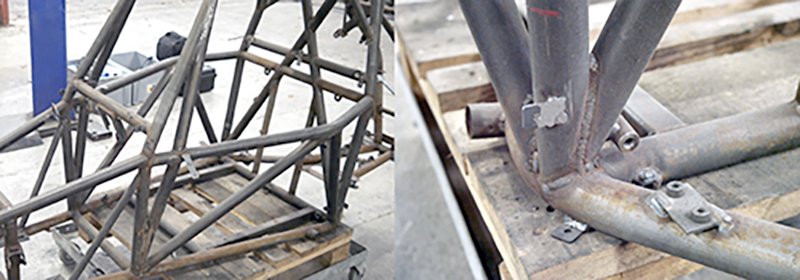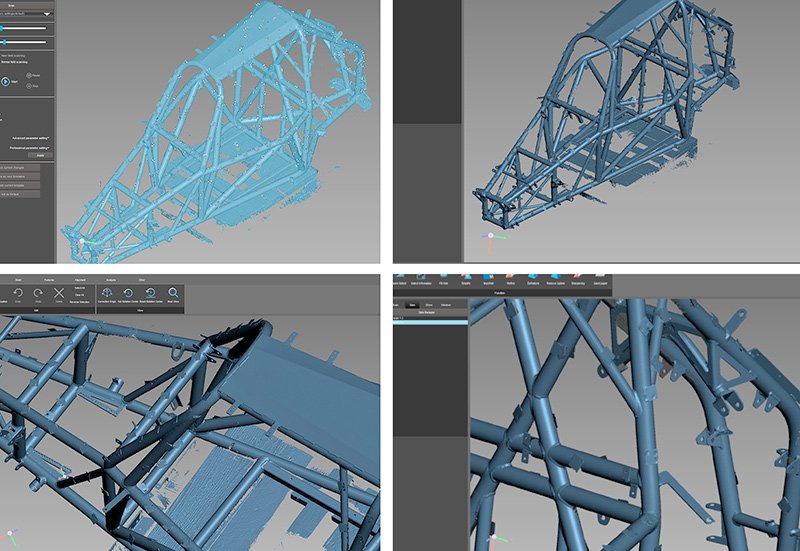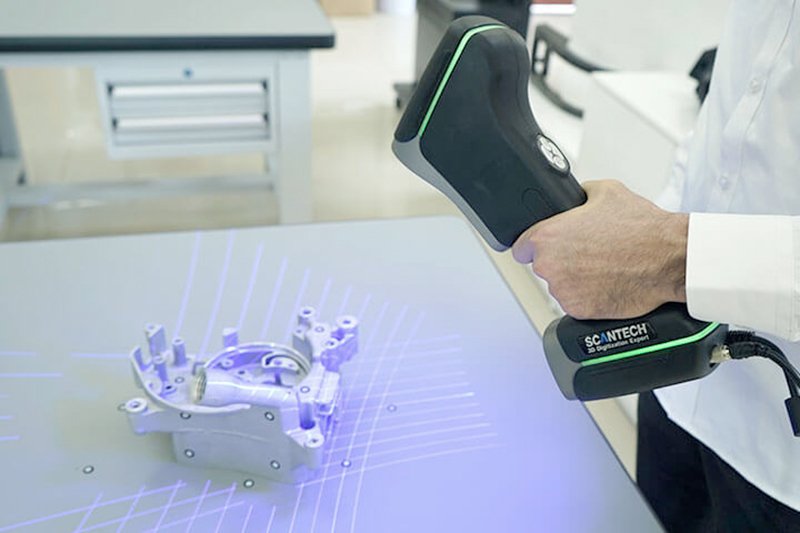3D Design and Maintenance on Racing Vehicle with Scantech 3D Scanner
A France 3D Scanning company, BTRD3D, helped LR Motor Company in France to scan the tubular chassis of a race vehicle using the 3D scanner KSCAN 20. The CAD model generated from the scanned data served as a basis for the development of a new product, which means helping the company to conceive a new high-performance buggy for competition.
Case Background
The chassis of race cars are different from those of ordinary cars, as the former focuses more on firmness, stability, and lightweight design. Those chassis are rigidly fabricated to meet the performance requirement of competitions.
Tubular chassis are mainly used in race cars due to the unrivaled sturdiness and the safety they provide. With a sturdy three-dimensional structure, they perform well in vibration and stability.
LR Motor Company is well-known for its high-performance buggies. Their tubular chassis has a strong bearing capacity and torsional rigidity, which are resistant to impact, distortion, and inertial force.
The project is to create a new CAD model for use in manufacturing, thus updating the original chassis. Generating a CAD model of the original product by the 3D scanner can empower the company to analyze its physical structure after wear and tear and explore how it can be improved to create variations.
Challenges of the project
The race cars of LR Motor Company are designed and fabricated by hand in their workshops, which highly depends on the personal experience and craftsmanship of experts. To shorten the manufacturing cycle time, the manufacturer must find a more efficient way to capture precise dimensional data of cars to serve as the reference for further design. To remodel one or a group of handmade components on CAD can be challenging.
An efficient solution for inspection and maintenance is also needed for in-service race cars. The parts of race cars are subject to wear and tear during the competition. It is necessary to identify potential wear parts in time to conduct thorough maintenance. The traditional procedure is complex, and the tools are complicated, which fails to accomplish the urgent tasks.
At the end of the racing season, the manufacture must upgrade the race cars for higher performance and a smoother driving experience. It means that the manufacturer has to have a clear understanding of the data of the original components.
Scantech’s 3D solutions
This is where our 3D scanning technology can help. Using the 3D scanner, you can obtain a very high-precision digital twin of elements. It will be used as a “3D layer” to remodel objects.
In this project, LR Motor Company hired our reseller to capture the 3D data of the original tubular chassis for further design.
The 3D scanning was carried out with Scantech’s portable 3D scanner KSCAN 20 in LR Motor’s workshop. Technicians captured the accurate data of longitudinal side member, cross member, cross braces and etc.
The scanning results are shown as below:
The 3D scan data serves as a visual guide for creating the CAD model. In this project, armed with precise 3D data, engineers were able to get a CAD model of the chassis to prepare the manufacturing of a new product that has really high performances.
Besides, 3D scanners can also be used by race teams to conduct a precise and in-time inspection of the wearing of parts. It can help them to intuitively identify the wearing parts and maintain the vehicle. The 3D scanner is simple to operate, and it can deliver intuitive data. Therefore, it can reduce the use of various inspection tools and greatly simplify the detection and maintenance process.
At the end of the racing season, with the reference of the data captured from in-service race cars, the manufacturer can identify wearing parts precisely to put forward an optimized design scheme.
Advantages of Scantech’s 3D solution
Simple Operation
The tubular chassis is bulky and not easy to transport. Our portable 3D scanner supports on-site measurement with few targets so that all the measurements can be done right in the workshop. Thanks to its simple operation, it facilitates the measurement setup and data acquisition.
High efficiency
It is not suitable taking measurements of tubular chassis with traditional contact measurement methods due to its organic and complex shapes. With non-contact measurement provided by KSCAN 20, engineers can precisely capture the geometric data and convert the data to mesh files instantly, which can be seamlessly integrated into design software.
High performance
The accuracy of 3D scanning is 0.020 mm/m, the volume accuracy is 0.035 mm/m, up to 0.02 mm/m, thanks to the photogrammetry module integrated into the scanner. Its 60x60cm standard field of view makes the scan very easy. It performs well on dark surfaces due to its powerful algorithm. The entire structure was scanned in high resolution to get maximum details on small features such as fixtures and holes.
Cost efficiency
Starting with precise measurements is the key to success. The data captured by KSCAN 20 serves as the basis for product design, maintenance, and iteration. In this way, the manufacturer can shorten manufacturing cycle time and fabricate race cars with better performance.
Summary
Portable 3D scanner KSCAN 20 can capture the whole geometries of various parts, especially the elements and their environment to ensure high performance. High-resolution, versatile, easy-to-use, and quick 3D scanning tools and software are the solutions to fulfill your goals and overcome your challenges






